
Sustainability is a concept that can be understood in many different ways. We like to view it as the application of new technologies and practices in order to transform existing systems into ones that have a lower environmental impact while keeping the same level of efficiency. Sustainability doesn’t manifest itself out of thin air – it takes research, solutions, and investments of both time and money.
As an environmentalist, I find myself recognizing problems in many different forms, but while identifying an issue is one thing, finding a valid solution is a whole separate issue. Solutions to environmental concerns are often not clear cut and require the cooperation and coordination of several different moving pieces coming together to compromise, create new technologies, and rethink the ways current systems work. I’d like to look at a sustainability issue many of us are familiar with and explore the routes one could take to arrive at different sustainability outcomes.
Energy is nothing short of a necessity in today’s highly connected and automated world. Without energy modern agriculture would simply cease to function, millions of bank accounts would be lost, and hundreds of thousands would suffer from exposure. As we currently stand, the United States, China, Russia, and India are still the largest consumers of fossil fuel for electricity. [1] There are many ways to minimize our overall dependence on non-renewable energy sources, one of which being reducing our usage in the transportation sector.
While the electric car market has been pushed heavily to mitigate individual carbon footprints, electric cars are still widely reliant on fossil fuel industries to generate the electricity required to charge the batteries (depending on where the city’s power grid draws electricity from). In this case, simply creating more electric cars isn’t the only requirement to make a difference. Additionally, renewable sources of energy such as solar, wind, and hydroelectric need to be built in order to match the increasing demand in electricity for vehicles, as opposed to petroleum. Not only do these sources of renewable energy need to match demand, but they have to be implemented in a way that supports local power grids without obstructing increasingly valuable farmland or defacing the natural ecosystem and having minimal vulnerability to outages caused by natural disasters.
Another aspect that must be considered is the batteries themselves. Electric vehicles primarily use batteries which rely on lithium, a finite resource. As demand for lithium increases, so will the need to extract more, which is a process that can be as intrusive for the environment as coal mining. [2] Once the batteries are spent, they must be recycled efficiently, which would require another level of logistic management, recycling facility technology, and oversight to ensure responsible practice.
The environmental impact of producing enough lithium batteries to achieve the goal that 50% of all vehicles manufactured are electric by 2030 cannot be understated – especially when a study done by Toyota found that almost a third of a car’s lifetime emissions occur in its initial manufacturing and transportation stage. [3] They further found that manufacturing electric vehicles and hybrids have higher emissions than a regular car – largely due to the need to mine, refine, and then produce lithium batteries. It could be that for the time being it is better just to buy used until electric vehicles gradually roll out and take over the market with the proper infrastructure to support them.
It seems that attempting to implement a fully sustainable solution to an outdated practice can seem like swimming in semantic circles, but this is an important part of the process. By no means was this article meant to turn you, the reader, against the idea of electric vehicles. I am simply examining every aspect of the process which has proximity to impacting the environment. Sustainability is often complicated, never clear cut, and always an uphill battle. Breaking down large processes into smaller pieces and examining each cause and effect while keeping our planet’s best interest in mind is one way we environmentalists like to critically think about sustainability issues.
